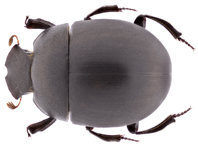Abstract
The Neotropical genus Allobates Zimmerman & Zimmerman (1988) is a large monophyletic clade composed of 54 described species distributed between Central America and South America (Frost, 2019; Grant et al., 2017). Twelve species have been recorded in Colombia, mostly distributed in the eastern flank of the Eastern Cordillera and Amazonian Region, although some species reach the Magdalena Valley and the Central and Western Cordillera (Acosta-Galvis, 2017).
References
Acevedo, A.A., Martínez, M.P., Armesto, L.O., Solano, L., Silva, K. & Lizcano, D. (2016) Detection of Batrachochytrium dendrobatidis in amphibians from Northeastern Colombia. Herpetological Review, 47 (2), 220–226.
Acosta-Galvis, A.R. (2017) Lista de los anfibios de Colombia: referencia en línea V.07.2017.0. Available from: http://www.batrachia.com (accessed 12 December 2018).
Barrio-Amorós, C.L. & Santos, J.C. (2009) Description of a new Allobates (Anura, Dendrobatidae) from the eastern Andean piedmont, Venezuela. Phyllomedusa, 8 (2), 89–104.
https://doi.org/10.11606/issn.2316-9079.v8i2p89-104
Frost, D.R. (2019) Amphibian species of the world: an online reference. Version 6.0. Available from: http://research.amnh.org/herpetology/amphibia/index.html (accessed 12 December 2018)
Grant, T., Rada, M., Anganoy-Criollo, M., Batista, A., Dias, P.H., Jeckel, A.M., Machado, D.J. & Rueda-Almonacid, J.V. (2017) Phylogenetic systematics of dart-poison frogs and their relatives revisited (Anura: Dendrobatoidea). South American Journal of Herpetology, 12 (1), S1–S90.
https://doi.org/10.2994/SAJH-D-17-00017.1
Hall, T.A. (1999) BioEdit: a user-friendly biological sequence alignment editor and analysis program for Windows 95/98/NT. Nucleic Acids Symposium Series, 41, 95–98.
IUCN SSC Amphibian Specialist Group (2012) Allobates algorei. The IUCN Red List of Threatened Species. Available from: http://www.iucnredlist.org/ (accessed 20 December 2018)
Kumar, S., Stecher, G. & Tamura, K. (2016) MEGA7: molecular evolutionary genetics analysis version 7.0 for bigger datasets. Molecular Biology and Evolution, 33 (7), 1870–1874.
https://doi.org/10.1093/molbev/msw054
Minh, B.Q., Nguyen, M.A.T. & von Haeseler, A. (2013) Ultrafast approximation for phylogenetic bootstrap. Molecular Biology and Evolution, 30, 1188–1195.
https://doi.org/10.1093/molbev/mst024
Nguyen, L.T., Schmidt, H.A., von Haeseler, A. & Minh, B.Q. (2015) IQ-TREE: a fast and effective stochastic algorithm for estimating maximum-likelihood phylogenies. Molecular Biology and Evolution, 32 (1), 268–274.
https://doi.org/10.1093%2Fmolbev%2Fmsu300
Tamura, K., Nei, M. & Kumar, S. (2004) Prospects for inferring very large phylogenies by using the neighbor-joining method. Proceedings of the National Academy of Sciences, 101 (30), 11030–11035.
https://doi.org/10.1073%2Fpnas.0404206101
Zimmermann, H. & Zimmermann, E. (1988) Etho-Taxonomie und zoogeographische artengruppenbildung bei Pfeilgiftfröschen (Anura: Dendrobatidae). Salamandra, 24 (2–3), 125–160.

